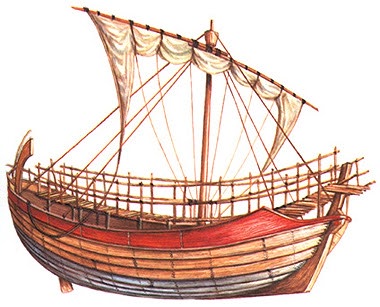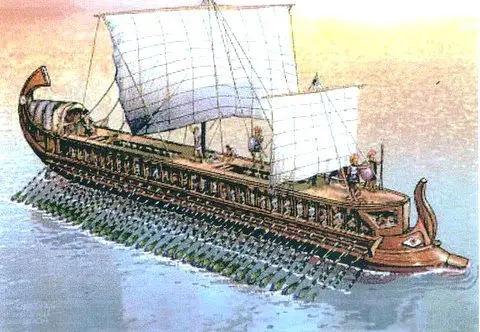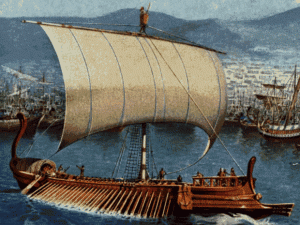Boating and sailing occupied a crucial place in the Greek way of living. As a matter of fact, the entire civilization was based on Ancient Greek boat transportation. The reasons for the same were twofold namely for facilitating the import and export of goods both within Greece as well as outside Greece and also because the mountainous topography of Greece made sailing by default the easiest way.
Why were boats so important to ancient Greeks?
Due to the Geography of Ancient Greece, the cities were mostly close to the seas and they preferred waterways rather than land routes for transportation and trade. So boats, ships, and sailing became a very important part of ancient Greek life. They used boats and ships for a number of reasons. Fishing was a good source of income, for trade, for conquering other territories and even for piracy boats and ships were used.
Deficiencies in Ancient Greek ships
Ancient Greek sailing was greatly limited by technological deficiencies and preferred to keep sight of land until absolutely necessary to go away from lands as compasses were still not invented. It was the Romans who came to use Astrolabes which made sailing much easier.

Ancient Greek Navy
Additionally, wars also made it vital to have knowledge about sailing as navies became a requisite during such wars. Like for instance, in the Battle of Salamis which took place in 480BC, Athens won over Persia only on the basis of its strong navy. Such was the importance of boating and sailing in ancient Greece.
Greek Boats
Ancient Greek Boats usually had 2 or 3 sails depending on the size of the boat. These boats were made using large pieces of hardwood. A large sized boat if used for the transportation of stone for the purpose of making statues could carry 100 to 150kg of stone.
These boats were also used for the transport of raw materials which were needed for construction purposes like iron, bronze etc. Occasionally, even food items like almonds, barley, fish, olives etc were transported by putting a wax seal on the top.

In ancient Greece, there existed a special road which was called as Diolkos. The specialty of this road was that this road connected two seas. Hence people could travel from one sea to another without having to change their Ancient Greek Boats. This length of this road was about 175kms. Subsequently, however, this road turned green due to seaweed and barnacles which grew into it.
Types of Ancient Greek Ships
These were namely the military ship, the cargo ship along with these two were the small crafts. While the military, as well as the cargo ships, were of great importance, the small crafts were only used for the purpose of transport of just a few people. Though initially, the ships in ancient Greece were very basic or elementary yet with the passage of time the Greeks made substantial improvements which made the ships travel faster ultimately resulting in making the Greeks powerful sailors.

Beginning with the Greek warships, these were initially long, narrow and single level ships. These ships were basically used for transfer troops to the sight of the battles and hence they were designed in such a manner so as to reach the destination as quickly as possible.
Earlier versions of warships
There was no leading ship type until 800 BC. The earliest shops were mainly used to carry troops and marine battles were rare. The Penteconter was the first specialized war galley during the archaic period. It consisted of 25 oars on both sides and had a length UP TO of 38 meters. It could muster a speed of about 10 knots. This type of ship is even mentioned in writings of Homer about the Trojan war.
Bireme was another warship galley that came into development around 700 BC. It could be around 80 feet long and had two sets of oars. They were even used by Romans to great effect.
Ancient Greek Trireme
Trireme was a development of the earlier used Pentekontors which consisted of 25 oarsmen on each side and the bireme, which was another warship which consisted of two branches of oars. One of the most prominent warships to be used during this time was called the Trireme which came to be extensively used around 500BC. This trireme was extremely rapid and reached up to 14 knots under good weather conditions. The trireme was 118 feet in length, 18 feet wide and 8.5 feet tall. As many as 170 oarsmen propelled this warship.
It was developed around the 6th and 7th centuries and was mastered by the Athenians. It was almost 30 to 50 meters long. It was a brilliant ship of the era where it could travel almost 350 km. It offered a great advantage in speed and maneuverability.
However, only 14 soldiers could be carried in one trireme at one time as by then ships were mainly used in naval battles rather than for transporting troops. In spite of all these advantages, this trireme suffered from one major drawback which was that because these Ancient Greek Boats were light, it could very easily be blown off due to high winds. Another difficulty of this type of ship was it required a very drilled crew which took a lot of time making it quite costly to maintain and also difficult to replace the crewmen if they are killed in battle.
Usage of the Ancient Greek warships
The best example of the effectiveness of these ancient Greek warships is the Persian wars. They managed to defeat a huge armada of the Persian fleet which outnumbered the Greeks. The triremes were so effective mainly because of their construction which made it very easy to break open an enemy ship.
Again after the Persian wars, these warships were again greatly used and became an integral part of the Peloponnesian war where Athens dominated the seas but was ultimately defeated when the Spartans built their own fleet with Persian help. It was a war that was fought mainly on the seas to transport troops, attack trade routes, etc.

Cargo ships
Immediately after the warships, the cargo ships were of utmost importance. These ships were mainly used for the purpose of import and export. Hence, the prosperity of ancient Greece could be attributed to these ships. The traders went all the way from Greece to Egypt, Italy, and even Spain.
The major advantages of these cargo ships were that they required comparatively lesser time to reach if compared to travel by road. Additionally, due to the complicated mountainous terrain, it was the water transport which was most favored by the people.

Since these ships had to travel into the winds, they usually sailed in the zigzag pattern. In the beginning around 40BC, these ships weighed around 150 tons. However, by 240BC, the weight of these ships increased to somewhere between 350-500 tons.
Navigation was crucial to a sailors survival. Hence, every man was expected to not only know the basic intricacies involved in boating and sailing but also to master them in order to be assured of his safe arrival to his destination.
Did the ancient Greeks name their ships?
It is difficult to ascertain weather all the ships in ancient Greece was named like it is done today. There are few examples even from Greek mythology which show the ships were named, like Argos. a ships built with the help of gods and named after its builder.
Why do Greek ships have eyes?
In many triremes we have found, were marked with eyes. It is believed they along with other things kike nameplates, ornaments and even painted figureheads were used to express the wealth of the owner and also to make it look frightening. It is also said that the Greeks believed these eyes was a nod to the presence of supernatural creatures which guided the ship in their and also save them from any oceanic hazards and accidents.